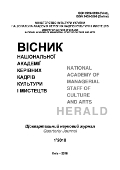CRITICAL DISCOURSE, LINGUISTICS AND CINEMA
DOI:
https://doi.org/10.32461/2226-3209.1.2018.177289Анотація
Abstract. Few studies examine the relationship between critical discourse, linguistics, and cinema; applying
micro- and macro-linguistic analysis as a method leading to defamiliarization of the natural discourse of a film. This study aims to analyze the nature of critical discourse and linguistics’ attitude toward cinema, based on which it can be concluded that in cinema, signs in form of critical discourse analysis have significant positions and are defined in relation to other signs of that individual discourse. Signs, which are considered to be central points, are defined differently by other discourses after they are recognized for the first time. Therefore, it is possible to find out the competitions occur in determining the meaning. These competitions are detected through methods of rival discourses, which fixed contents into floating signifiers. Considering the critical comparisons in rival discourses, it can be concluded that each group, based on its specific approach, tries to define the central points and breaksdown the structures of those signs in the rival discourses.
Keywords: Discourse, Cinema, Central Signifier, Sign.
Посилання
Afrashi, A. (2005).StructuralAnalysis of Semiotic Layers of Spiritual Cinema. Tehran: Binab Magazine, No. 9
(192-196).
Arnheim, R. (1997). Film Essays and Criticism. University of Wisconsin Press.
Berger, A. A. (2000).Media Analysis Techniques. (P. Ejlali, Trans.).Ministry of Culture and Islamic Guidance,
Publication Center.
Elsaesser, T. (2004).A Review of Linguistic SemiologicalStudies of Cinema. (F. Sasani, Trans.). Tehran: SooreMehr.
Fairclough, N. (2000). Critical Discourse Analysis. (Motarjeman Group, Trans.). Tehran: Media Research Institute.
Foucault, M. L'Archéologie du Savoir [The Archeology of Knowledge] (A. Sheridan, Trans. 117.
Hawarth, D. R. Discourse Theory, and Political Analysis. (Soltani., Trans.). Political Science 2, 155.
Homayounpour, S. (2004).The Representation of Women in Iranian Cinema before and after Revolution (1979)
(Master’s Thesis). Faculty of Art, Alzahra University.
Hosseini Zadeh, M. A. Discourse Theory, and Political Analysis. Political Science 28, 182.
Jorgensen, M., Phillips, L. (2002). Discourse Analysis as Theory and Method. (H. Jalili., Trans.).
Laclau, E. and Chantal, M. (1985). Hegemony and Socialist Strategy: Towards a Radical Democratic Politics.
London: Verso.
Manouchehri, A. (2008). Approach and Method in Political Science. 1 st ed. Tehran: SAMT.
Marsh, D., Stoker, G. Theory and Methods in Political Science. (A. M. Haji Yousefi., Trans.), 207.
Moghadami, M. T. (2011). Laclau and Mouffe's Discourse Analysis Theory and Its Criticism. Marefatefarhangi,
(2).
Stam, R. (2004). Film Theory: An Introduction. (Motarjeman Group, Trans.). Tehran: SooreMehr.
Tajik, M. R. Text; Simulacrum and Discourse analysis. Gofteman, 1(1).
Van Dijik, T. (2001).Multidisciplinary CDA: A Plea for Diversity.In R. Wodak, & M. Meyer, eds., Methods of
Discourse Analysis. London: Sage.
##submission.downloads##
Номер
Розділ
Ліцензія
Автори, які публікуються у цьому журналі, погоджуються з наступними умовами:
1. Автори залишають за собою право на авторство своєї роботи та передають журналу право першої публікації цієї роботи на умовах ліцензії Creative Commons Attribution License, котра дозволяє іншим особам вільно розповсюджувати опубліковану роботу з обов'язковим посиланням на авторів оригінальної роботи та першу публікацію роботи у цьому журналі.
2. Автори мають право укладати самостійні додаткові угоди щодо неексклюзивного розповсюдження роботи у тому вигляді, в якому вона була опублікована цим журналом (наприклад, розміщувати роботу в електронному сховищі установи або публікувати у складі монографії), за умови збереження посилання на першу публікацію роботи у цьому журналі.
3.Політика журналу дозволяє і заохочує розміщення авторами в мережі Інтернет (наприклад, у сховищах установ або на особистих веб-сайтах) рукопису роботи, як до подання цього рукопису до редакції, так і під час його редакційного опрацювання, оскільки це сприяє виникненню продуктивної наукової дискусії та позитивно позначається на оперативності та динаміці цитування опублікованої роботи.

